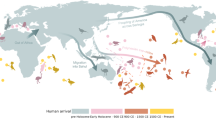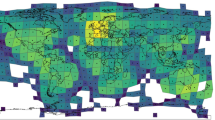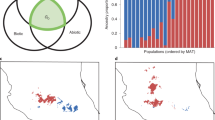Abstract
Arising from: C. D. Thomas et al. Nature 427, 145–148 (2004); see also communication from Buckley & Roughgarden and communication from Harte et al.;Thomas et al. reply Thomas et al.1 model species-distribution responses to a range of climate-warming scenarios and use a novel application of the species–area relationship to estimate that 15–37% of modelled species in various regions of the world will be committed to extinction by 2050. Although we acknowledge the efforts that they make to measure the uncertainties associated with different climate scenarios, species' dispersal abilities and z values (predictions ranged from 5.6% to 78.6% extinctions), we find that two additional sources of uncertainty may substantially increase the variability in predictions.
Similar content being viewed by others
Main
First, the study by Thomas et al. is based on projections of species-range shifts from a variety of niche-based models supplied by different contributors using different modelling methods. For instance, generalized linear models were used to model plants in Europe, whereas generalized additive models were used for Protea species in South Africa, and genetic algorithms for taxa in Mexico. Although niche-based models are all based on the same principle, they use a variety of assumptions, algorithms and parameterizations. Therefore, combining assessments from different models is likely to introduce further unquantified model effects.
To illustrate this, we fitted four niche-based modelling techniques, using the same five bioclimatic variables2, to distributional data for a representative sample of European plant diversity (1,350 endemic and non-endemic plant species) under a similar range of climate scenarios to those of Thomas et al.1. To estimate extinction risk, we used each of the three methods employed by them and compared two scenarios of dispersal abilities: universal and none (Table 1). Thomas et al.1 consider differences in extinction predictions between a range of climate-warming scenarios, but our analyses indicate that differences might be at least as strong between models. For example, when using method (3) under a maximum expected warming scenario, predictions from the four models were in the range 2–4.2% with universal dispersal, and in the range 2.3–10.1% with no dispersal. By contrast, when using method (3) and only one model (generalized linear model), the range for predictions across the three climate scenarios was reduced: a range of 2.7–3.6% with universal dispersal, and 8.2–10.0% with no dispersal.
Second, although Thomas et al.1 show (their Table 4) that their models are highly sensitive to the ‘slope’ (z value) of the species–area relationship, neither their models nor ours yet provide any means of quantifying the uncertainty arising from the simplistic link between proportionate reduction in area and extinction likelihood. Cases of long-term species persistence in remarkably small ranges (for example, on mountain tops and oceanic or land-bridge islands3) demonstrate that, although range reduction is a key driver of species decline, we need to investigate the scale-sensitivity of model outputs and translate projections of range reduction into projections of species losses.
These uncertainties mean that the range of possible extinction risks arising from climate change may be even wider than that reported by Thomas et al.1.
References
Thomas, C. D. et al. Nature 427, 145–148 (2004).
Thuiller, W. Global Change Biol. 9, 1353–1362 (2003).
Brown, J. H. & Lomolino, M. V. Biogeography 2nd edn (Sinauer, Sunderland, Massachusetts, 1998).
Nakicenovic, N. & Swart, R. Emissions Scenarios: A special report of working group III of the Intergovernmental Panel on Climate Change (Cambridge Univ. Press, Cambridge, 2000).
Author information
Authors and Affiliations
Corresponding author
Rights and permissions
About this article
Cite this article
Thuiller, W., Araújo, M., Pearson, R. et al. Uncertainty in predictions of extinction risk. Nature 430, 34 (2004). https://doi.org/10.1038/nature02716
Issue Date:
DOI: https://doi.org/10.1038/nature02716
This article is cited by
-
Climate warming and dispersal strategies determine species persistence in a metacommunity
Theoretical Ecology (2022)
-
Uncertainty in ensembles of global biodiversity scenarios
Nature Communications (2019)
-
Extinction risks of a Mediterranean neo-endemism complex of mountain vipers triggered by climate change
Scientific Reports (2019)
-
Evidence and mapping of extinction debts for global forest-dwelling reptiles, amphibians and mammals
Scientific Reports (2017)
-
The potential range of Ailanthus altissima (tree of heaven) in South Africa: the roles of climate, land use and disturbance
Biological Invasions (2017)
Comments
By submitting a comment you agree to abide by our Terms and Community Guidelines. If you find something abusive or that does not comply with our terms or guidelines please flag it as inappropriate.



